Volume 14 Number 1
©The Author(s) 2012
Action Research to Address the Transition from Kindergarten to Primary School: Children's Authentic Learning, Construction Play, and Pretend Play
Abstract
Children experience demanding changes during the transition from early childhood programs to primary school. Research shows that children’s initial academic and social success at school can affect their long-term adjustment, achievement, and success. The authors, both early childhood teachers in Singapore, undertook an action research project that involved using young children’s constructions and pretend play to adapt a transition-related challenge into an authentic learning experience for a group of fourteen 5- to 6-year-olds in a suburban kindergarten. The teachers employed the action research cycle of data gathering and reflection about teaching practice and learner needs, planning and implementation of change to address the problem, and additional data gathering and reflection to assess the effects of the change and to determine future modifications. The teachers concluded that the activities achieved successful cognitive and affective outcomes in supporting the children’s ability to apply what they had learned to solve a real-life problem outside the classroom. The children’s positive experience contributed to helping them develop positive attitudes about school prior to transition. It also contributed to reducing one potential cause of anxiety and stress for the children and their parents.
Introduction
Children experience demanding changes during the transition from early childhood programs to primary school in both developed and developing countries (Arnold, Bartlett, Gowani, & Shallwani, 2008; Giallo, Treyvaud, Matthews, & Kienhuis, 2010) regardless of the variation in age of starting school in different countries (Fabian & Dunlop, 2007). Research shows that children’s initial academic and social success at school can affect their long-term adjustment, achievement, and success (Fabian & Dunlop, 2007; Giallo et al., 2010; Peters, 2010). Research and theory on transition emphasize the importance of linkages, close coordination, and continuity between early childhood programs and primary schools (Arnold et al., 2008; LoCasale-Crouch, Mashburn, Downer, & Pianta, 2008). A strong argument has also been made for helping children develop the skills and dispositions necessary for handling some of the challenges that they face during the process of transition (Arnold et al., 2008). This paper presents an action research project in which we adopted an innovative approach to address an issue in children’s transition from an early childhood program to primary school. We describe how we integrated young children’s constructions and pretend play to adapt a transition-related challenge into an authentic learning experience for a group of 14 children ages 5 to 6 years in a suburban kindergarten in Singapore.
Context of the Research
In Singapore, young children attend preschools—either child care centers or kindergartens—prior to entering primary school at the beginning of the year in which they reach 7 years of age. Child care centers provide half- or full-day care and education programs for young children between 2-1/2 and 6 years old. Kindergartens offer 3- to 4-hour preschool educational programs for children between the ages of 4 and 6 years. Kindergartens are registered with the Singapore Ministry of Education and are run by the private sector, including community foundations, religious bodies, social organizations, and business organizations. The daily program of kindergartens includes learning activities that develop language and literacy skills, basic number concepts, simple science concepts, social skills, creative and problem-solving skills, appreciation of music and movement, and outdoor play. Children learn in two languages—English as the first language and Chinese, Malay, or Tamil as a mother tongue.
Methods
Participants
We were two early childhood teachers among a teaching staff of five (two males and three females) in a private kindergarten that we owned and operated. One of us had 8 years of experience as a Montessori early childhood teacher. The other had worked as an early childhood educator for 4 years. The kindergarten had an enrollment of 42 children between 4 and 6 years old; most were from middle to upper middle socioeconomic backgrounds. This action research was undertaken in the program’s eighth year of operation and involved a group of fourteen 5- to 6-year-olds—five girls and nine boys.
Setting
Set in the suburbs of the city, our kindergarten has an outdoor play/garden area of approximately 400 square meters (4,000 square feet) and four classrooms totaling approximately 200 square meters (2,000 square feet). The school program runs two 3-hour sessions between 8:00 a.m. and 2:30 p.m., Monday through Friday. The school year follows the school calendar set by the Ministry of Education and comprises four terms of 10 weeks each. The school adopts a vertical grouping approach that allows one-to-one teaching, project work in small groups, and interactions among children of different ages.
The Singapore Ministry of Education provides a curriculum outline to serve as a guide, but individual schools are free to develop curricula within these guidelines, subject to the approval of the Ministry. Our kindergarten curriculum was initially based on the Montessori method (Abdullah, 2001; Lillard, 1996), but we found it to be overly structured after 2 years of working with this approach. This dissatisfaction led to the introduction of the Project Approach into the curriculum, while basic numeracy and literacy skills continued to be taught using the Montessori materials.
In the Project Approach, children typically work on a topic of their choice, and they are actively engaged in exploring, investigating, thinking, communicating, decision making, problem solving, and reflecting (Helm & Katz, 2001; Katz & Chard, 2000). The process generally comprises three phases. In the first phase, the children discuss what they already know and share their current experiences in relation to their chosen topic. The children are encouraged to formulate questions for further investigation. In the second phase, teachers support the children in their research and investigation as they seek answers to their questions. This process may involve field trips, invited speakers, reference materials, studying real objects, and visits to the library. The children then represent their findings through multiple means, including writing, drawing, visual art, drama, or play. In the last phase, the children present and share their work in some form with others. They are also encouraged to reflect on their experience.
Data Gathering and Reflection
This action research project was carried out in response to consistent expressions of concerns and questions from parents over their children’s readiness for entry into primary schools. We adopted a process that involved the cycles of data gathering and reflection about teaching practice and/or learner needs, planning and implementation of change to address the problem, and then data gathering and reflection to assess effects of the change and to determine future modifications (Cunningham, 2008).
A review of the literature revealed that early childhood programs can play an important role in initiating transition activities to help children with the dramatic change they experience when they enter primary schools (Arnold et al., 2008; LoCasale-Crouch et al., 2008). These activities include individual meetings between early childhood teachers and primary school teachers who are responsible for new entrants, dialogue between early childhood teachers and parents in discussing children’s transition problems, introducing activities and skills that children would need for school, and arranged visits to primary schools (Arnold et al., 2008; Fabian & Dunlop, 2007; LoCasale-Crouch et al., 2008). Awareness and sensitivity on the part of early childhood teachers and earlier initiation of transition measures have been found to be important factors contributing to successful transition (LoCasale-Crouch et al., 2008). Besides literacy and numeracy, Janus and Offord (2000) identify social competence, communication skills, and general knowledge as some of the developmental skills that children should possess in order to be able to learn effectively in school. Dockett and Perry (2001) argue that transition programs should go beyond an orientation visit to primary schools to address specific needs of children and families.
Reflecting on our own practice, we realized that we could do more than arranging children’s visits to primary schools and inviting primary school teachers to visit our early childhood program. Reflection on our own practice led us to identify two important areas for improvement. First, we had not at that time targeted specific areas of skills that children would need to help them manage the challenges that they might face during the transition. Second, we did not have a systematic approach to identifying important transition issues that were of concern to both the parents and the children.
We decided to gather information through informal interviews with three sources: (1) past graduates of our school, whom we regularly invited back to share their primary school experiences with our children, (2) the parents of these children (either through interviews in person or over the telephone), and (3) parents of children who would be entering primary school the following year when they picked up their children or when they were at our kindergarten (we encourage parents to volunteer in our programs or to spend time with their children during “a special day with your child” sessions). Field notes were recorded in writing and coded to identify commonalities (Stringer, 2007). We spoke to 10 parents and 5 children who had graduated from the program and were attending 5 different primary schools. Our data revealed three key findings:
- Both parents and children said that it could be challenging and stressful for new entrants to purchase their own meals in the school canteen at the beginning of the year.
- The children indicated that the transition from the informal kindergarten setting to a more formal and structured learning environment of a primary school required some adjustment on their part.
- The parents reported varying degrees of concern over their children’s ability to cope with the learning expectations of the primary school, especially in terms of numeracy and literacy.
We decided to address the first issue because the experience of handling currency notes and coins to purchase something constituted, in effect, a real-life test of the children’s numeracy skills, self-confidence, and independence. Self-sufficiency has been identified as one of several abilities required by children to be ready for school (Fabian & Dunlop, 2007). In an extensive review of the literature on transition issues, Peters (2010) identifies 11 key strategies that teachers could implement, including “considering children’s whole experience of school, including lunchtimes and using toilets” (p. 3). Therefore, we wanted to address the following questions:
- How could we turn this potentially stressful challenge of purchasing food at the school canteen into a learning experience that would be engaging and enjoyable for our children?
- How could we address both the cognitive and affective aspects of the experience?
Planning and Implementation of Change
We wanted to develop an authentic learning experience for the children. “Authentic learning” involves problem solving, which is a central part of everyday life. Children, in particular, constantly encounter situations and challenges that are new to them (Siegler & Alibali, 2004). As an integral part of the learning process, children apply knowledge that they have gained in the classroom to real problems. Authentic learning is frequently defined as learning in which students acquire and use knowledge in real-life contexts, and it involves solving problems that are meaningful, challenging, and complex (Galarneau, 2005; Renzulli, Gentry, & Reis, 2004). It occurs within social contexts that often involve ill-defined problems, uncertainties, and ambiguities (Hung, Cheah, Hu, & Cheung, 2004; Renzulli et al., 2004). Authentic learning involves a community of learners collaborating and interacting with the wider community through field experiences (Rule, 2006), and it can provide students with opportunities to construct knowledge and acquire skills needed for success outside of school (Galarneau, 2005). It also addresses affective aspects of learning such as motivation, attitudes, and dispositions (Hung et al., 2004; Renzulli et al., 2004).
We also wanted to explore using children’s constructions and pretend play to prepare them for a new experience (attending primary school) by helping them to acquire and practice skills essential to solving a real-life problem. Educators view play as a powerful means of learning that supports the development of cognitive, social, and linguistic competence in the early years (Bergen, 2002; Jenkinson, 2001; Robson, 2006). Learning experiences that incorporate pretend play can encourage higher-order thinking, problem solving, self-regulation, and understanding of rules (Bergen, 2002; Whitebread, 2010).
We developed an action research plan that involved the following strategies:
- Teaching the children how to work with real money.
- Leveraging the children’s interest in constructions and pretend play to create opportunities for them to practice buying and selling using real money.
- Incorporating the experience of children purchasing their own food into an orientation visit to a primary school.
We decided to gather data during implementation of our plan by observing the children and taking photographs. A total of 32 observations were made; each observation lasted between 15 to 45 minutes. Both of us took field notes to record children’s actions and learning. We then reviewed and compared our field notes and photographs at the end of each session of observation. Audio-taping was used as a backup, and the voice recording data were only referred to when we felt the need for clarification and/or verification of our field notes.
Analysis of data was informed by the interpretive model of analysis (Hatch, 2002). The process included close reading of the data for a sense of the whole and to identify impressions that were then recorded in memos. Each of us independently studied the memos for salient interpretations, rereading the data and noting places where the interpretations were supported or challenged. When we disagreed about a coded segment of data or the choice of a particular code, we discussed the interpretations until both of us could conscientiously reach an accord. To enhance credibility, a colleague who was not involved in the research then reviewed the coded segments as part of the peer debriefing procedure (Lincoln & Guba, 1985).
The process enabled us to develop and finalize a set of 19 codes. Strategies employed to enhance the credibility, dependability, confirmability, and transferability of the study (Lincoln & Guba, 1985) comprised prolonged engagement and persistent observation in the field; memo writing to chart the steps taken in the interpretation of data; efforts to enhance intercoder agreement, to search for discrepant evidence, and to clarify assumptions that might cause bias or misinterpretation (Creswell, 2007; Harris, Pryor, & Adams, 1997; Thomas, 2006); maintaining an audit trail by recording ongoing reflection and interpretation through memo-writing; and keeping records of field notes and photographs (Merriam, 1998). A summary of the interpretations was drafted, and supportive excerpts were identified.
Introducing the Challenge
We initiated the discussion of the topic with the children during one of our regular project-based learning sessions. We described to them the visit that would involve touring the school facilities and buying their own lunch at the school canteen. In a group discussion facilitated by one of the teachers, the children developed individual lists of questions that they wanted to find answers to during their field trip (see Appendix A). In the course of the discussion, the children decided that each of them would be responsible for a specific area of investigation during the visit, such as the school canteen, the classroom, and the library. They discussed how to document their findings and generated the following strategies:
- Write it down.
- Tell everyone.
- Make drawings.
- Take photos and print them out.
- Everyone has his or her own list (of questions).
We discussed at length the challenge of buying their meals at the school canteen. Some of the children were already aware of the challenge because older siblings or their parents had spoken to them about it:
E: My brother say(s) tuckshop (school canteen) is very big with many shops to buy food. And lots of people.
N: My brother—he said you need to know how much to pay and how much to collect back.
X said his mother started to have him pay for his food when they ate in a food court or a fast-food restaurant. He said he needed help sometimes from his mother to pay the correct amount. When we asked the children how they could practice using money to make purchases, J suggested practicing buying and selling in the kindergarten’s pretend play corner. Building on the idea, we suggested that they create their own pretend food stalls so that they could “sell food” to their school mates. The children expressed excitement about our suggestion and decided to work in pairs on the project. They made a list of food stalls that they wanted to set up and wrote down what they would need to create their stalls.
Preparation
We conducted a series of five mini-lessons to support the children with knowledge essential for their field trip. We first introduced different denominations of coins: 1 cent, 5 cents, 10 cents, 20 cents, 50 cents, and a dollar, using real money. With our support, the children then worked on the question, “How many cents are there in a 5-cent coin, 10-cent coin, a 20-cent coin, a 50-cent coin, and a dollar coin?” They worked on counting in 5s, 10s, 20s, and 50s (Figure 1).
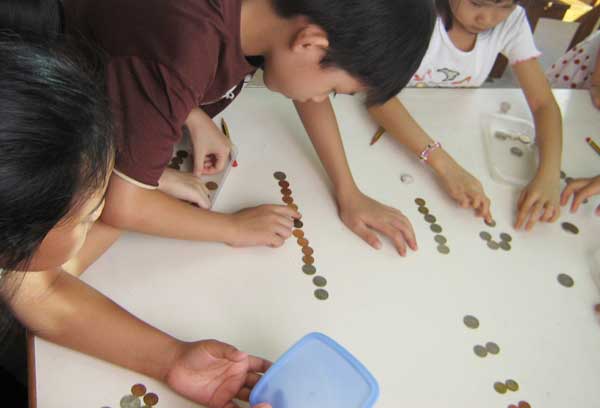 Figure 1. Children counted and worked with real money.
Figure 1. Children counted and worked with real money.
The children also played a game that involved matching actual amounts of money to listed prices of an array of pretend food (Figure 2).
 Figure 2. Children played a game of matching money to listed prices of pretend food.
Figure 2. Children played a game of matching money to listed prices of pretend food.
We then introduced small groups of the children to a game of buying pretend food, requiring them to pay both the exact amount and more than the exact amount so that they could have change returned.
At the end of the lessons, we asked the children why they thought they needed to learn how to make cash payments with their coins. We recorded the following responses:
- So when we grow up, we know how to use it.
- When something is 60 cents, then we can give 60 cent(s) correctly.
- We can buy things.
- Next year when we go to primary school, we need to buy things ourselves.
Creation of Food Stalls Using Recycled Materials
The children decided to pair up to work on building food stalls during six project sessions in the course of 3 weeks. We provided the class with a wide range of recycled materials to build the stalls (Appendix B). We minimized our intervention to allow the children to explore and experiment with the materials in order to identify suitable items for making their props. For example, we responded to the children’s requests or questions by encouraging them to find their own solutions to problems and to improvise using the materials already provided. We encouraged communication and thoughtful actions by asking what they were planning to do or what they were doing and making. The results of their work included stalls for selling chicken rice (a popular local dish), fruit, drinks, fish and chips, and sandwiches.
Chicken Rice Stall
Two of the children, F and B, planned, designed, and created their own menu for their stall using text, symbols, numerals, and diagrams. The choices they made for their menu appeared to be foods commonly available at home or in food courts. For example, they chose chicken rice (a local dish) because it was their favorite food, and they priced the “chicken rice meal” based on what they learned from their siblings. They decided on prices for a variety of “set meals,” such as chicken rice with a drink and chicken rice with jelly dessert (Figure 3). A teacher recorded part of their conversation when they were making their decisions:
F: Cannot be too expensive.
B: My sister’s school—they sell chicken rice for one dollar.
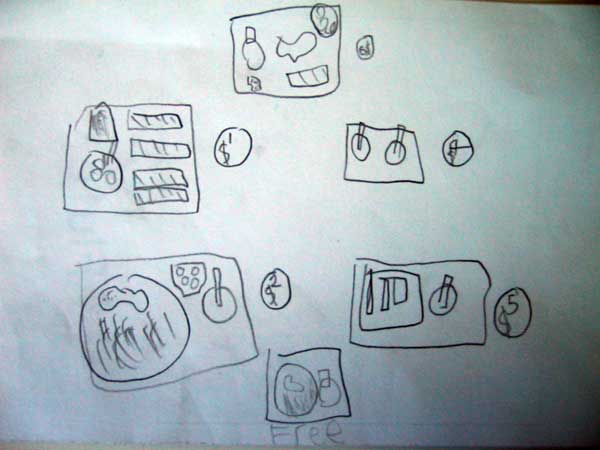 Figure 3. The chicken rice stall menu showed prices for a variety of meals.
Figure 3. The chicken rice stall menu showed prices for a variety of meals.
They devised several strategies for representing the food, such as putting pieces of foam in a small plastic bottle and breaking the foam into small pieces with scissors to make “rice” (Figure 4).
 Figure 4. A chicken rice “set” was made from recycled materials representing strips of chicken meat, a drink, and a jelly dessert.
Figure 4. A chicken rice “set” was made from recycled materials representing strips of chicken meat, a drink, and a jelly dessert.
Fruit Stall
After deciding to make a fruit stall, KY and V devised a strategy to prop up a piece of cardboard on a recycled tissue paper box to create a signboard (Figure 5).
 Figure 5. Children wrote the word “fruits” on their signboard.
Figure 5. Children wrote the word “fruits” on their signboard.
The two children exhibited concentration and intense focus as they painstakingly cut the materials that they had chosen to make representations of grapes and cherries. V suggested using sponge materials and showed KY how she cut the sponge into strips. The teacher recorded their discussion:
V: We need to cut these into smaller bits.
KY: I can also cut strips of cardboard and cut into smaller bits for the grapes.
KY took some fabric and tried to squeeze it into a ball in her hand.
KY: We need to hold it together.
V looked around for something that she could use and found cellophane tape.
V: We can try the tape.
She wrapped cellophane tape around a ball of the fabric. Several attempts were required to make the tape hold the ball together.
We noted that KY and V worked cooperatively, generating strategies to overcome challenges and exploring and experimenting with possible solutions. Creative thinking for the purpose of problem solving (Robson, 2006) was evident in the work of creating a signboard and making representations of cherries and grapes. They applied mathematical concepts (e.g., classification, shape) when they chose specific colors and shapes for representations of apples, bananas, and oranges (Figure 6).
 Figure 6. KY and V made representations of bananas and oranges.
Figure 6. KY and V made representations of bananas and oranges.
They also used written text to identify their props, and they used text and numerals in their price list (Figure 7).
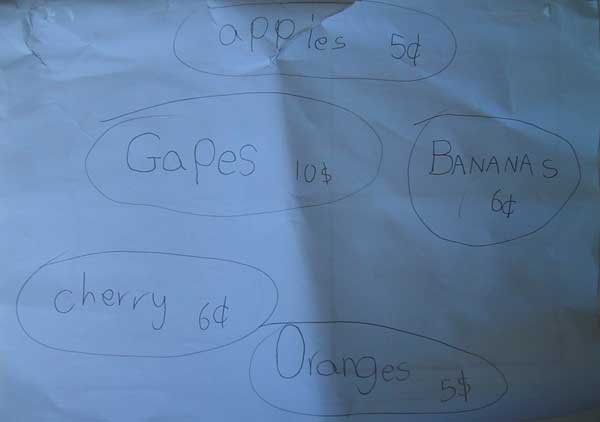 Figure 7. Creating the fruit stand price list involved using text, symbols, and numerals.
Figure 7. Creating the fruit stand price list involved using text, symbols, and numerals.
Drink Stall
N and J decided to sell drinks at their stall. As they worked, they engaged in problem solving and creative thinking—discussing the tasks, evaluating the potential of various recycled materials, and implementing their ideas to make cups and drink straws. For example, they taped a circular piece of bubble wrap on one end of a cardboard tube to create a cup and made a drink straw by rolling foam netting into the shape of a tube and securing it with cellophane tape (Figure 8).
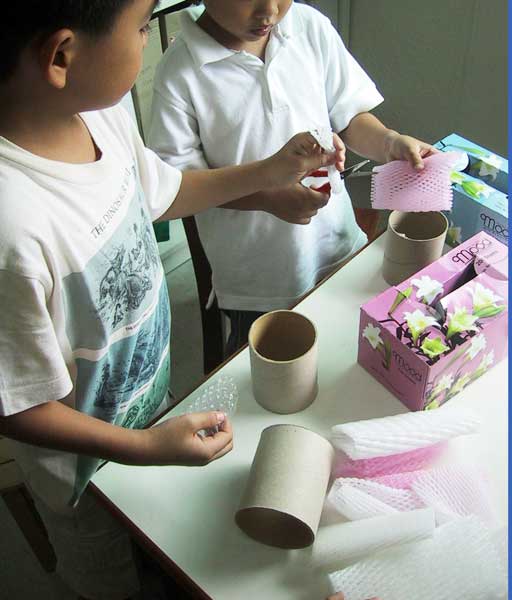 Figure 8. Two children made cups and drink straws from cardboard tubes, bubble wrap, and foam netting.
Figure 8. Two children made cups and drink straws from cardboard tubes, bubble wrap, and foam netting.
After making two sets of cups and straws, N and J discovered that it was much quicker to use the recycled drink straws and small plastic bottles that they found in another container of recycled materials (Figure 9).
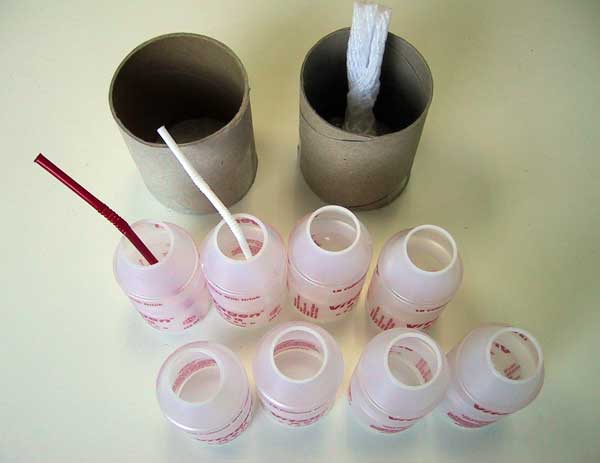 Figure 9. The children ultimately used two different approaches to making cups and drink straws.
Figure 9. The children ultimately used two different approaches to making cups and drink straws.
A teacher invited them to reflect on their decisions:
Teacher: Can you tell me why you used these instead? (Points to recycled drink straws and small plastic bottles.)
N: Because it is easier.
J: Yeah, we don’t have to make these (points to the earlier “cups” that they made).
Their actions seemed to show flexibility and adaptability, and their response to the teacher’s question suggested that their problem solving was a dynamic process that involved selecting a suitable strategy and evaluating the results and possible alternatives.
N and J also created a menu listing the prices of the drinks they wanted to sell in their stall (Figure 10).
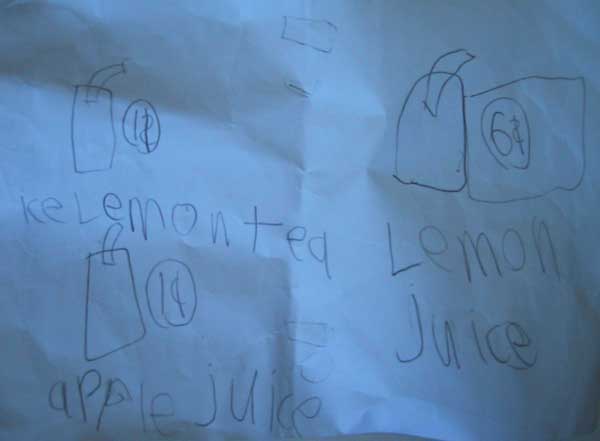 Figure 10. N and J made a list of drinks and their prices.
Figure 10. N and J made a list of drinks and their prices.
Fish and Chips Stall
As part of their work on a fish and chips stall, E and A invented a signboard that doubled as a cashier machine. They packaged their “fish and chips” based on prior knowledge of how food is served in a fast-food outlet. A teacher encouraged them to express this knowledge and to explain how they applied it by asking them questions:
Teacher: Can you tell me what this is?
E: It’s that thing that they press and then put money inside. You find it in fast-food restaurant where you pay money... pictures of food on top.
A: Put the fish and chip(s) in a box like this.
Teacher: What is this?
A: It’s a plastic tray. They do that in restaurants.
E: Yeah, Long John Silver (a fish and chips fast-food chain).
E and A also created “drinks” by stuffing recycled bottle corks into empty milk cartons (Figures 11 & 12).
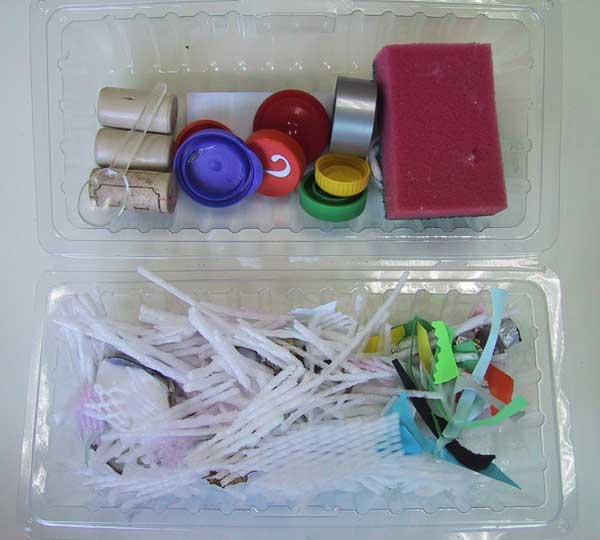 Figure 11. Drawing on personal experience at food outlets, two children developed packaging for fish and chips.
Figure 11. Drawing on personal experience at food outlets, two children developed packaging for fish and chips.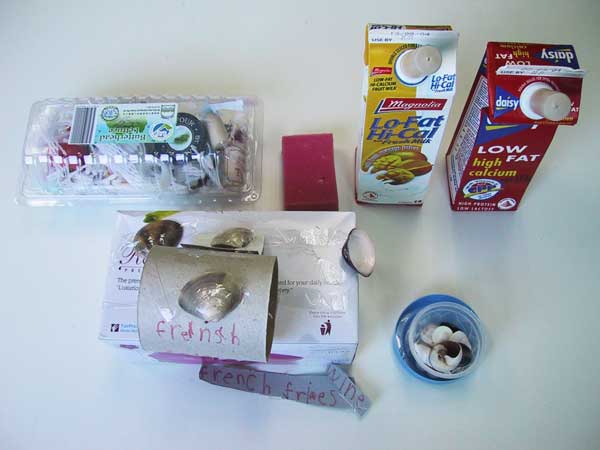 Figure 12. Children used recycled materials to create a fish and chips set, drinks, bowl of soup, and signboard/cashier machine (from top left and clockwise).
Figure 12. Children used recycled materials to create a fish and chips set, drinks, bowl of soup, and signboard/cashier machine (from top left and clockwise).
Sandwich Stall
V and G created a sandwich stall that offered a comprehensive menu listing the food items and their prices (Figure 13).
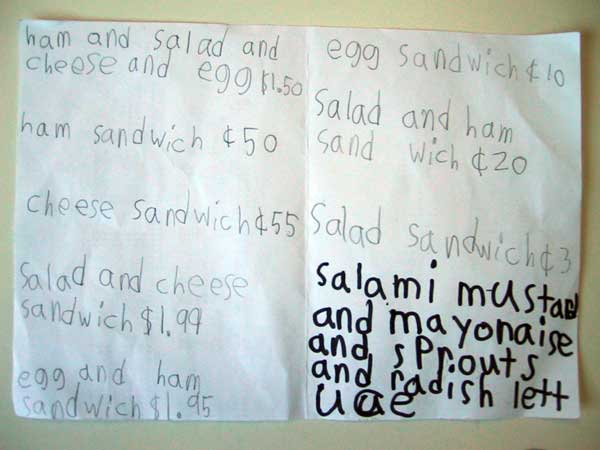 Figure 13. Creating the sandwich shop menu entailed using text, symbols, and numerals.
Figure 13. Creating the sandwich shop menu entailed using text, symbols, and numerals.
The two children used a variety of patterns, texture, colors, and shapes to make ingredients for the “food” available at the sandwich stall (Figure 14). For example, V drew brown lines on a circular piece of sponge, reflecting her knowledge of the appearance of a meat patty (Figure 15).
 Figure 14. The children made representations of a variety of sandwich ingredients.
Figure 14. The children made representations of a variety of sandwich ingredients.
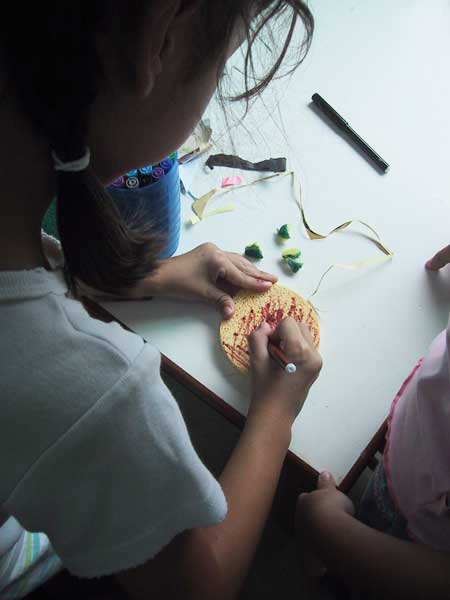 Figure 15. A circular piece of sponge was the basis for this representation of a meat patty.
Figure 15. A circular piece of sponge was the basis for this representation of a meat patty.
We noted that as the children worked on the food stalls in pairs, they had a number of opportunities to take initiative and exercise creativity, to use mathematical thinking, and to gain confidence about working out solutions for themselves (MacNaughton & Williams, 2008). They applied skills related to writing, communication, negotiation, and categorization in a variety of ways. They worked cooperatively to plan tasks, organize materials, and make the items they needed, generating ideas and strategies for solving problems that arose as they made the stalls.
Pretend Play: Buying and Selling
After completing the food stalls, the children engaged in pretend play related to buying and selling their food over the following 2 weeks. The following vignette illustrates how F and B negotiated the roles of cook, server, and cashier, and how they used logical-mathematical knowledge during their cash transactions:
B: Someone has to cook.
F: I serve customer, you cook.
B: Who is going to be the cashier?
B: I’ll be the cashier.
X: I want to buy chicken rice.
F: You want this chicken rice set or chicken rice with jelly set?
X: How much (is) the chicken rice set?
F: One dollar. The one with jelly is 50 cents more.
B extended a “chicken rice set” to X. F took it with his right hand and pulled it away from X before he could take it.
F (stretches out his left hand with open palm): You get your food after you pay. Give me your money.
F also showed awareness of typical sales procedures—the customer pays first, then receives food.
The teachers also observed V using complex communication skills to persuade a potential “customer” to purchase her fruit:
S: How much?
V: Sorry you cannot buy this. It’s not for sale.
S: Why?
V: I use this box for putting my money—it’s my money box.
S: Oh.
V: You want oranges? Veeery juicy. Only 5 cents for one.
S: ...
V: Maybe some apples? Nice and crunchy—also one for 5 cents.
S: Ok. I want two.
V: Ok. Two for 10 cents please. If you buy more, I give you a discount.
V and F were among several children who, during our observations, demonstrated awareness of the conventions and rules of buying and selling, including (in V’s case) knowledge of the practice of giving discounts for purchasing larger quantities.
The children’s pretend play involved multiple roles and symbolic use of props that both reflected and contributed to the development of their abstract thinking and imagination (Bodrova & Leong, 2004). Their role playing and negotiation supported their language development (Klein, Wirth, & Linas, 2004). The children also learned to work with real money during these activities.
Field Trip to the Primary School
The “visit program” was developed and arranged by the primary school. Four parent volunteers provided transport to and from the primary school and acted as chaperones during the trip. The tour guide was a host teacher appointed by the primary school administration. She was responsible for answering the children’s questions. The field trip began with a tour of the school’s teaching facilities. The children posed their questions to the host teacher or the teachers in the classrooms that they were visiting, recording answers to their list of questions on their individual clipboards by writing and drawing. At the library, for example, C interviewed the librarian:
C: How many books in the library?
Librarian (smiling): “A lot…. You want to count them?”
C went off to the rows of bookshelves and attempted to count the books. After going through one bookshelf, he came back to the group. He smiled and said, “A lot.” He then recorded “a lot” on his clipboard.
Although our children did not practice their questions beforehand, we noted that they were comfortable posing questions to the primary school teachers and librarian, who were strangers to them. We speculated that this comfort resulted from their familiarity with conducting interviews and surveys among their peers and teachers in the course of their project work. The children also brought cameras to take pictures.
The “finale” was a visit to the school canteen. The children went through the school canteen during the actual lunch time to experience how it felt to be in the midst of approximately 200 other students. However, the actual purchase of food by our children occurred after the lunch time was over. We felt that this arrangement would be more manageable for the children and would provide the stall personnel more time to interact with the children. (In practice, most schools in Singapore assign an older student to assist each new entrant with purchasing food at the beginning of the school year.) The children visited the various food stalls before deciding what they wanted to buy, and they used the money that they brought with them to pay for their food (Figure 16). Some children confidently gave the exact amount or collected the correct amount of change, while others needed our help.
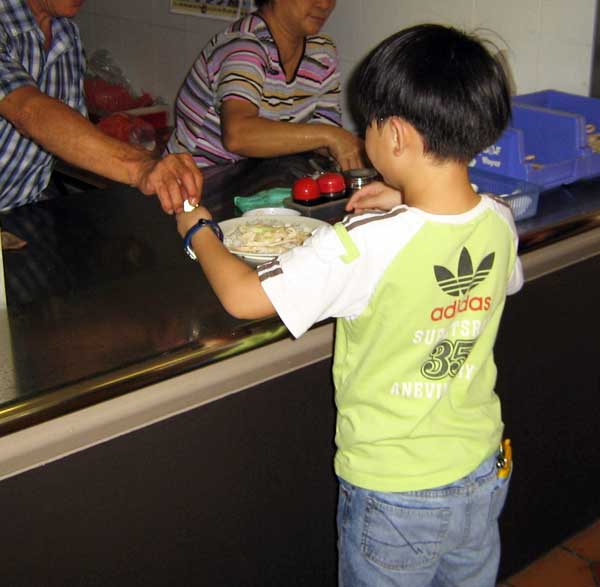 Figure 16. Children purchased food at the primary school canteen.
Figure 16. Children purchased food at the primary school canteen.
Back at school, we asked each child individually in a discussion involving all 14 children what he or she thought about the visit to the primary school. We received a range of responses, many of which focused on experiences in the school canteen:
J: There is a lot of food there (school canteen). I ate bread with jelly. I like the canteen very much, and there are lots of stalls. There are lots of drinks too.
F: I like it because I can buy my own food.
G: V lent me 50 cents because I didn’t have enough (money).
X: All the things at the school are fun…. I like the exercise room because I can exercise on all these things. I like all the things at the school. It is very fun at the assembly hall because you can do a lot of things at assembly hall.
Following Up: The Newsletter
The children discussed several ways to inform their parents of what happened during their field trip. They spoke about telling their parents, writing a letter, and sending out a newsletter “like the one you gave out” (the school newsletter that we gave to parents every school term). The last comment led them to examine a copy of the newsletter. While the children looked through the newsletter, R noticed the newspapers on the shelf where we kept recycled materials for their project work and art activities. He said, “I know, we can make it like a newspaper—daddy reads the newspaper every morning.” This suggestion led to the group decision to combine the concepts of a school newsletter and a newspaper, creating a “school newspaper.” When the teacher asked how they would design their newspaper, the class explored a variety of options. One child suggested looking at a copy of the national newspaper, The Straits Times, for ideas. With the teacher’s help, they observed and identified the following newspaper conventions:
- A newspaper has a “title” at the top of the front page.
- The date is written below the “title.”
- Articles have “lines” separating them.
- Articles have “pictures and words.”
- Articles have their own “titles.” Some words are “bigger” and “fatter” and the other words are smaller.
- The name of the reporter is written at the top of the article and below the “title.”
The children applied these conventions in creating their own newspapers. We divided the class into two groups of seven and gave them A3-sized paper (420 mm by 297 mm or 16.54 inches by 11.69 inches). They worked together to create a masthead with the newspaper’s name. One group wrote theirs on a separate piece of paper, then cut and pasted it on an A3-sized paper. The other group wrote the name directly on their paper. Each child reported on what he or she had done during the field trip, including some of the answers obtained to his or her investigative questions. Individuals decided on titles for their own articles and selected photographs or drawings to use. The teachers printed black and white copies of the photographs taken during the field trip. Some children cut and pasted the photo prints, while others decided to draw their own pictures.
R’s contribution to the newspaper was typical of articles that the children wrote:
...the tuck shop (school canteen) has lots of things I like to eat. I like...noodles, snack and chocolate and froggy snacks. And all different kinds of foods. Different (kinds) of fruit. Different kind(s) of vegetables.
The children took turns writing their articles on the A3-sized papers. After each person completed an article, the individual used the convention of “lines” to demarcate his or her section before passing the newspaper to the next reporter.
Feedback from Parents
The teachers spoke informally to eight parents who picked up their children after school in the subsequent week to ask what they thought about the primary school visit and the children’s experience of purchasing food at the school canteen. Telephone calls generated feedback from another four parents. Field notes were recorded in writing. We reviewed, summarized, and tabulated the responses according to positive feedback and negative feedback. Feedback from these parents revealed that they all had positive feelings about our initiative. They were unanimous in the view that the experience offered the opportunity for the children to get to know what a primary school environment could be like. Eight parents mentioned that the children had practiced important skills necessary for making purchases in the school canteen. Comments from parents included:
This is really helpful. They can take better care of themselves when they go to school.
I am less anxious now about how to help my child.
More practice is always helpful. You have also given us an idea about what we can do on our part.
Evaluation and Reflection
At the beginning of this action research project, we identified, through interactions with the children and their parents, a real-life challenge of significance to the community, a challenge in which the children were emotional stakeholders. Specifically, we knew that the children had concerns about adjustments required by the transition from kindergarten to primary school. Parents expressed varying degrees of concern about their children’s ability to cope with the primary school’s academic expectations, especially regarding numeracy and literacy. Parents and children identified purchasing meals in the primary school canteen as potentially challenging and stressful for new entrants.
In response, we planned a series of experiences that we felt could address the children’s and parents’ concerns and interests. We intended to capitalize on the children’s natural interest in play to help familiarize them with some aspects of primary school and, specifically, with the process of buying their meals. We anticipated that these authentic learning experiences (as defined earlier in this article) would offer valuable opportunities for the children, and we were keen to see how we might integrate such experiences into our program’s curriculum.
We observed that the processes involved in constructing food stalls, working with real money, going on the school visit, and creating the newspapers offered many of the pedagogical advantages of both pretend play and authentic learning. These combined experiences encouraged the children to be proactive and flexible. We saw them persevere and persist in tackling problems that they encountered. Children developed their own strategies for using recycled materials to create their food stalls. Working with real money enhanced their mathematical learning. They applied creative thinking, problem solving, communication, and literacy skills as they worked on their stalls and their newspapers. All of these activities occurred within a community of learners that emphasized cooperative learning and group dialogue, shared responsibility for learning, decision making, and construction of knowledge and meaning by the students.
The classroom activities helped the children to feel more confident about making purchases in the real “tuckshop.” Their experiences seemed to contribute to their positive attitudes about their prospective schools and about their own ability to make adjustments that transition would require. Feedback from parents also suggested that this approach to preparing for the transition helped to reduce one potential cause of parental anxiety prior to the children’s entrance to primary school.
Considerations for the Next Action Research Cycle
A number of issues could be addressed in the next cycle of action research. We found, for example, that the children showed varying proficiency at understanding the amount of money needed for making a purchase; some needed more time to work on the processes involved. More practice over a longer period of time in simulated contexts prior to the primary school visit might enhance individual children’s understanding of money and competence in handling it.
We would also need to develop a system for informally assessing the progress of children’s competence at making purchases. For example, perhaps an arrangement could be made with the primary school for the teachers to observe the kindergarten children during a second experience at the school canteen with older children present.
A number of methodological issues would need to be addressed in subsequent cycles of this action research project. For example, we could have sought the assistance of an outside person with methodological training and experience in qualitative research methods to read the coded data memos and interpretations for the purpose of better triangulation of interpretations and peer debriefing. Systematic and comprehensive in-person interviews with the parents could help us obtain more in-depth feedback from the parents, including suggestions for improvement. More in-depth questioning to probe what the parents valued, and why, might help us to minimize, although perhaps not totally eliminate, the halo effect potentially associated with the new initiative. Feedback could also be sought from the host teacher of the primary school with regard to the usefulness of the exercise.
It would be useful to determine the post-transition impact of this initiative, although we feel that this would be methodologically challenging given the potential involvement of other factors such as efforts by the parents and by other primary schools.
Overall, our data suggest that the experiment of using children’s constructions and pretend play as a scaffolding support in an authentic learning context achieved what we had hoped it would. The activities appear to have contributed to positive cognitive outcomes, enabling the children to remain deeply engaged in experiences that capitalized on their application of prior and newly acquired knowledge, including literacy and numeracy skills, toward meaningful goals.
References
Abdullah, Aisha Z. (2001). Why Montessori? Choosing the right preschool. Singapore: Times Books International.
Arnold, Caroline; Bartlett, Kathy; Gowani, Saima; & Shallwani, Sadaf. (2008). Transition to school: Reflections on readiness. Journal of Developmental Processes, 3(2), 26-38.
Bergen, Doris. (2002). The role of pretend play in children's cognitive development. Early Childhood Research & Practice, 4(1). Retrieved January 27, 2012, from http://ecrp.illinois.edu/v4n1/bergen.html
Bodrova, Elena, & Leong, Deborah J. (2004). Chopsticks and counting chips: Do play and foundational skills need to compete for the teacher's attention in an early childhood classroom. In Derry Koralek (Ed.), Spotlight on young children and play (pp. 4-11). Washington, DC: National Association for the Education of Young Children.
Creswell, John W. (2007). Qualitative inquiry and research design: Choosing among five approaches (2nd ed.). Thousand Oaks, CA: Sage.
Cunningham, Billie M. (2008). Using action research to improve learning and the classroom learning environment. Issues in Accounting Education, 23(1), 1-30.
Dockett, Sue, & Perry, Bob. (2001). Starting school: Effective transitions. Early Childhood Research & Practice, 3(2). Retrieved January 27, 2012, from http:ecrp.illinois.edu/v3n2/dockett.html
Fabian, Hilary, & Dunlop, Aline-Wendy. (2007, May). Outcomes of good practice in transition processes for children entering primary schools. A working paper in early childhood education. The Hague, The Netherlands: Bernard van Leer Foundation.
Galarneau, Lisa. (2005). Authentic learning experiences through play: Games, simulations and the construction of knowledge. Paper presented at the Digital Games Research Conference 2005, Vancouver, Canada.
Giallo, Rebecca; Treyvaud, Karli; Matthews, Jan; & Kienhuis, Mandy. (2010). Making the transition to primary school: An evaluation of a transition program for parents. Australian Journal of Educational and Developmental Psychology, 10, 1-17.
Harris, Judith; Pryor, Jeffry; & Adams, Sharon. (1997). The challenge of intercoder agreement in qualitative inquiry. Retrieved November 28, 2005, from http://emissary.wm.edu/templates/content/publications/intercoder-agreement.pdf
Hatch, J. Amos. (2002). Doing qualitative research in education settings. Albany: State University of New York Press.
Helm, Judy Harris, & Katz, Lilian G. (2001). Young investigators: The project approach in the early years. New York: Teachers College Press.
Hung, W. L. David; Cheah, Horn Mun; Hu, Chun; & Cheung, Wing Sum. (2004). Engaged learning: Making learning an authentic experience. Teaching and Learning, 25(1), 1-17.
Janus, Magdalena, & Offord, Dan. (2000). Readiness to learn at school. ISUMA: Canadian Journal of Policy Research, 1(2), 71-75.
Jenkinson, Sally. (2001). The genius of play: Celebrating the spirit of childhood. Stroud, UK: Hawthorn Press.
Katz, Lilian G., & Chard, Sylvia C. (2000). Engaging children's minds: The project approach (2nd ed.). Stamford, CT: Ablex.
Klein, Tovah P.; Wirth, Daniele; & Linas, Keri. (2004). Play: Children's context for development. In Derry Koralek (Ed.), Spotlight on young children and play (pp. 28-35). Washington, DC: National Association for the Education of Young Children.
Lillard, Paula Polk. (1996). Montessori today: A comprehensive approach to education from birth to adulthood. New York: Schocken Books.
Lincoln, Yvonna S., & Guba, Egon G. (1985). Naturalistic inquiry. Thousand Oaks, CA: Sage.
LoCasale-Crouch, Jennifer; Mashburn, Andrew J.; Downer, Jason T.; & Pianta, Robert C. (2008). Pre-kindergarten teachers’ use of transition practices and children's adjustment to kindergarten. Early Childhood Research Quarterly, 23(1), 124-139.
MacNaughton, Glenda, & Williams, Gillian. (2008). Techniques for teaching young children: Choices in theory and practice (3rd ed.). Frenchs Forest, Australia: Pearson Education.
Merriam, Sharan B. (1998). Qualitative research and case study applications in education. San Francisco: Jossey-Bass.
Peters, Sally. (2010). Literature review: Transition from early childhood education to school. Wellington, New Zealand: University of Waikato.
Renzulli, Joseph S.; Gentry, Marcia; & Reis, Sally M. (2004). A time and a place for authentic learning. Educational Leadership, 62(1), 73-77.
Robson, Sue. (2006). Developing thinking and understanding in young children: An introduction for students. New York: Routledge.
Rule, Audrey C. (2006). The components of authentic learning. Journal of Authentic Learning, 3(1), 1-10.
Siegler, Robert S., & Alibali, Martha Wagner. (2004). Children's thinking (4th ed.). Upper Saddle River, NJ: Prentice Hall.
Stringer, Ernest T. (2007). Action research (3rd ed.). Thousand Oaks, CA: Sage.
Thomas, David R. (2006). A general inductive approach for analyzing qualitative evaluation data. American Journal of Evaluation, 27(2), 237-246.
Whitebread, David. (2010). Play, metacognition and self-regulation. In Pat Broadhead, Justine Howard, & Elizabeth Wood (Eds.), Play and learning in the early years: From research to practice (pp. 161-176). Thousand Oaks, CA: Sage.
Author Information
Dr. Scott Lee is currently a Research Fellow at the Australian Catholic University, after graduating with a Ph.D. from the University of Otago, New Zealand. Prior to his current position, Dr. Lee lectured part-time at the University of Otago and taught young children between 3 and 6 years old at his own preschool in Singapore. Scott also possesses a M.Sc. degree in early childhood education from Wheelock College, Boston. His research interests include young children's thinking skills and problem solving, children's construction play, and cultural perspectives of play-based learning.
Scott Lee
Australian Catholic University
Level 3, 174 Victoria Parade
East Melbourne, Victoria 3002
Australia
Email: wfleescott@gmail.com
Garry Goh is a trained Montessori teacher. He earned his M.Sc. in early childhood education from Wheelock College, Boston, and completed his Graduate Diploma in Teaching (Primary Education) at the University of Otago, New Zealand. He is now a teacher at an early childhood center in Queenstown, New Zealand.
Appendix A
Sample of Children’s Questions
- What is in the classroom?
- How many minutes in the class?
- How many times can you go to the toilet?
- Do boys and girls go to the same toilet?
- How many computers are there?
- How many books (are there) in the library?
- What kinds of shops are there?
- How many tables and chairs (are there)?
- What play equipment is there (in the playground)?
- How many slides (are there) in the playground?
Appendix B
List of Recycled Materials
- Seashells
- Wood
- Pebbles and stones
- Dried flowers
- Dried leaves
- Twigs
- Seedpods
- Acorns
- Sand
- Eggshells
- Fabrics
- Buttons
- Strings
- Assorted bottle caps
- Wine corks
- Boxes
- Plastic bottles
- Marker caps
- Paper confetti
- Magazines
- Ice-cream sticks
- Newspapers
- Pipe cleaners
- Paper clips
- Rubber bands
- Wire

